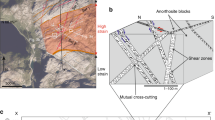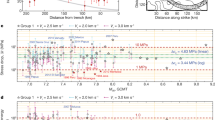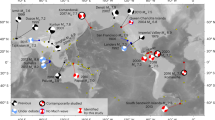Abstract
EARTHQUAKES at depths of > 300 km are similar to shallower events in that they are dominantly of double-couple character1, implying that shearing motion has taken place at depth. But because increased friction at these high pressures inhibits brittle fracture2,3, various other mechanisms, related to phase transformations, have been invoked to explain the occurrence of deep earthquakes4–10. As yet, however, no consistent differences have been found between the source characteristics of deep (>300 km) and intermediate-depth (<300km) earthquakes2,11–13. Here we report a systematic global survey of the rise times and stress drops of deep and intermediate earthquakes. (The rise time is defined as the time from rupture initiation to peak moment release rate.) When the rise times are scaled to the seismic moment release of the events, their average is nearly twice as fast for events deeper than ∼ 450 km as for shallower events. This difference may ultimately provide an experimental means of testing proposed mechanisms for the generation of deep seismicity.
This is a preview of subscription content, access via your institution
Access options
Subscribe to this journal
Receive 51 print issues and online access
$199.00 per year
only $3.90 per issue
Buy this article
- Purchase on Springer Link
- Instant access to full article PDF
Prices may be subject to local taxes which are calculated during checkout
Similar content being viewed by others
References
Kawakatsu, H. Nature 351, 50–53 (1991).
Frohlich, C. Ann. Rev. Earth planet. Sci. 17, 227–254 (1989).
Griggs, D. T. & Handin, H. Mem. geol. Soc. Am. 79, 347–373 (1960).
Green, H. W. & Burnley, P. C. Nature 341, 733–737 (1989).
Burnley, P. C., Green, H. W. & Prior, D. J. J. geophys. Res. 96, 425–553 (1991).
Kirby, S. H. J. geophys. Res. 92, 13789–13800 (1987).
Sung, C. M. & Burns, R. G. Tectonophysics 31, 1–32 (1976).
Liu, L.-G. Phys. Earth planet. Inter. 32, 226–240 (1983).
Meade, C. & Jeanloz, R. Science 252, 68–72 (1991).
Kirby, S. H., Durham, W. B. & Stern, L. A. Science 252, 216–225 (1991).
Kuge, K. & Kawakatsu, H. Geophys. Res. Lett. 17, 227–230 (1990).
Abe, K. J. Phys. Earth 30, 321–330 (1982).
Wyss, M. & Molnar, P. Phys. Earth planet. Inter. 6, 279–292 (1972).
Bridgman, P. W. Am. J. Sci. A243, 90–97 (1945).
Green, H. W., Young, T. E., Walker, D. & Scholz, C. Nature 348, 720–722 (1990).
Kanamori, H. & Anderson, D. L. Bull. seism. Soc. Am. 65, 1073–1095 (1975).
Dziewonski, A. M. & Woodhouse, J. H. J. geophys. Res. 88, 3247–3271 (1983).
Fukao, Y. & Kikuchi, M. Tectonophysics 144, 249–269 (1987).
Vidale, J. E. Geophys. Res. Lett. 14, 542–545 (1987).
Houston, H. Geophys. Res. Lett. 17, 1021–1024 (1990).
Dziewonski, A. M. & Anderson, D. L. Phys. Earth planet. Inter. 25, 297–356 (1981).
Rubie, D. C. & Brearley, A. J. Nature 348, 628–631 (1990).
Akaogi, M., Ito, E. & Navrotsky, A. J. geophys. Res. 94, 15671–15686 (1989).
Poirier, J. P. in Anelasticity of the Earth, Geodyn, Ser. Vol. 4, 113–117 (American Geophysical Union, Washington DC, 1981).
Burnley, P. C. & Green, H. W. Nature 338, 753–756 (1989).
Vaughan, P. J. & Coe, R. S. J. geophys. Res. 86, 389–404 (1981).
Ashby, M. F. & Verrall, R. A. Phil. Trans. R. Soc. lond. A288, 59–95 (1978).
Frohlich, C. J. geophys. Res. 92, 13944–13956 (1987).
Author information
Authors and Affiliations
Rights and permissions
About this article
Cite this article
Houston, H., Williams, Q. Fast rise times and the physical mechanism of deep earthquakes. Nature 352, 520–522 (1991). https://doi.org/10.1038/352520a0
Received:
Accepted:
Issue Date:
DOI: https://doi.org/10.1038/352520a0
This article is cited by
-
Similar seismic moment release process for shallow and deep earthquakes
Nature Geoscience (2023)
-
Faulting of Rocks in a Three-Dimensional Stress Field by Micro-Anticracks
Scientific Reports (2014)
-
A break in the deep
Nature (1994)
-
Deep quakes shake up debate
Nature (1994)
-
A deep earthquake aftershock sequence and implications for the rupture mechanism of deep earthquakes
Nature (1994)
Comments
By submitting a comment you agree to abide by our Terms and Community Guidelines. If you find something abusive or that does not comply with our terms or guidelines please flag it as inappropriate.



